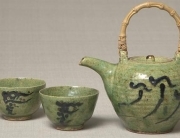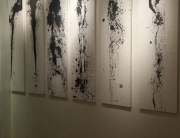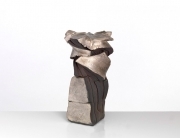Onimaru Hekizan is a prominent takatori yaki artist that deserves a great deal of attention these days. Takatori yaki tea sets by Onimaru Hekizan are part of the collections of Zen Buddhist temples in Japan. For instance, the Silver Ginkaku-ji and Daitoku-ji temples in Kyoto hold pieces from Onimaru-sensei’s work in their collections.
Therefore, the Yakimono Gallery in Paris is particularly glad to have displayed pieces from this aforementioned artist. Nevertheless, it would be a good idea to gain a better understanding of what this style is before actually commenting on the artist’s work. Those who wish to appreciate it need to have a basic foundation on which to base their appreciation in the first place.
Takatori yaki art was born in one of the seven original Kobori kilns. Kobori Enshu founded these furnaces in 1630. The earliest known kiln at the base of Takatori in Chikuzen was built sometime before 1606. The production site changed five times throughout the seventeenth century.
When 1716 rolled around the entire workshop and kiln were moved west of Kuroda castle, into the Nishijin area at Fukuoka. Production stuck around there until the abolition of the initial domain system. Until 1871 the Kuroda lords of what’s now Fukuoka Prefecture controlled the Takatori style. The year 1871 brought sweeping changes, however.
This style primarily works with stoneware ceramic pieces. Aesthetics are particularly important when it comes to Takatori art. Unique ranges of colors like brown, green and blue are all used in the glazing process. These are all colors that are created from natural elements found by the artists who observed wildlife in their native Japan.
As a result the actual form and shape of these ceramics are also dictated largely by the observations that early artists made. Ultimately implementation has come to follow a very strict code. This code has gone so far as to even stipulate requirements in regards to how the wood used for firing is collected. Some artists have grown to be actually rather particular about this.
Wood is actually really interesting when it comes to kilns. Certain individuals have suggested that the choice of wood is based solely on superstitious or old traditions, but nothing could be further from the truth. Conventional wisdom shown by these artists has actually come to show that the wood they select is picked out for very serious reasons, and that it helps to produce the unique pieces of art that they’re going for.




